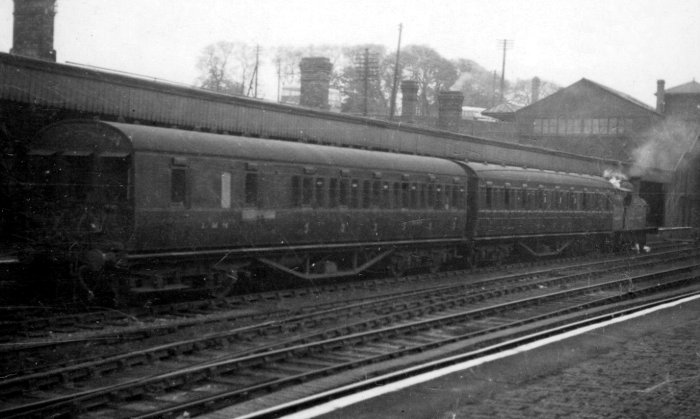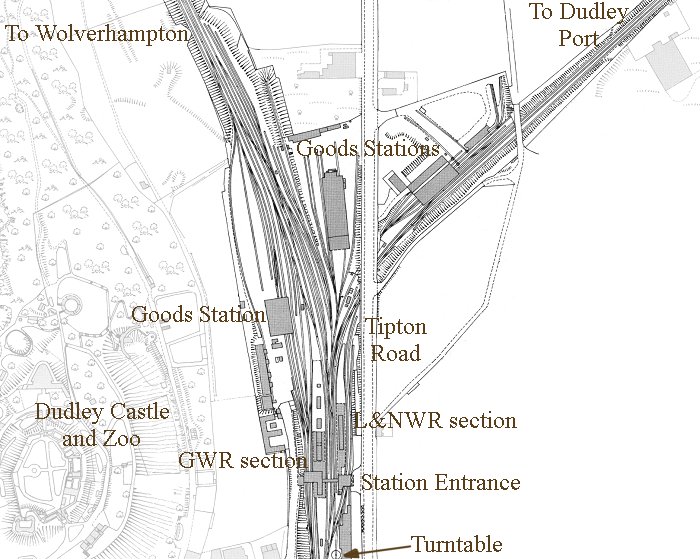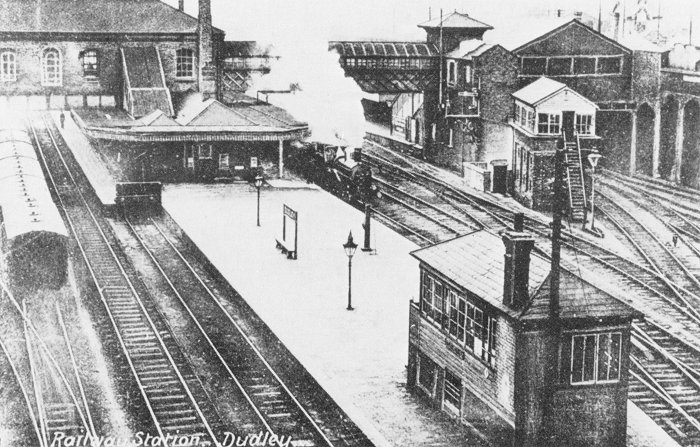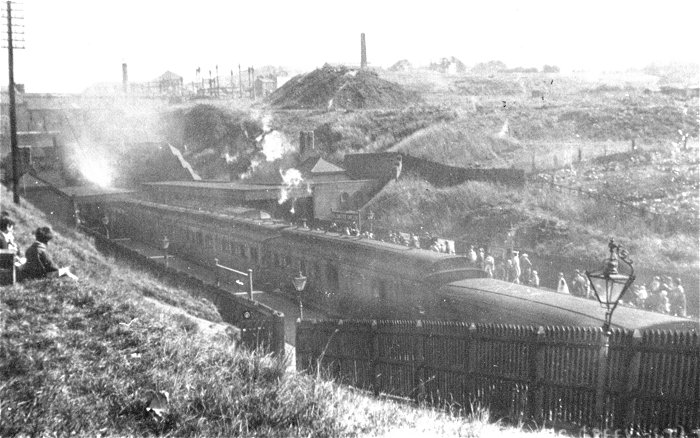|
Dudley railway station opened in 1850, with a
temporary wooden platform, slightly to the north of
the site of the later station. It adjoined a
goods shed. The station was built to the south of
Dudley’s racecourse, which was closed to make way
for the railway. This was at a time of intense
competition between the newly formed railway
companies, all trying to gain control of various
routes. The Oxford, Worcester &
Wolverhampton Railway
One of the main companies
involved, the Oxford, Worcester & Wolverhampton
Railway, came into existence when a bill was
passed in Parliament on the 4th August, 1845 to authorise the company to construct a line from
the Oxford & Rugby Railway at Wolvercot Junction, to
Worcester, Stourbridge, Dudley, and Wolverhampton,
with a branch to the Grand Junction Railway at Bushbury. At the time there was competition between
broad gauge and narrow gauge lines, and so the bill
stated that the track was to be mixed gauge from
Abbotswood near Worcester, northwards. It also stated
that if the Oxford, Worcester & Wolverhampton
Railway failed to complete the line, the Great
Western Railway should either lease the line, or
purchase the company and complete the line itself.
The chief engineer was I. K.
Brunel, who greatly underestimated the cost of
construction. His original estimate was
£1.5m but it was quickly realised that the actual
cost would be about £2.5m, so the Great Western
Railway increased its share to four percent.
Progress was extremely slow and all of the available
money was spent by June 1849. Only the middle
section of the line was anywhere near complete, and
so the company became known as ‘The Old Worse and
Worse’.
|

A local L.M.S. train
about to leave the station. From an old
postcard. |
The Railway Commissioners then
ordered the Great Western to complete the line, but
they refused, so a legal battle began. Completion of
the line was mainly due to the efforts of John
Parson, a London solicitor who became the company’s
legal adviser in 1850 and possibly the largest
shareholder. The Oxford, Worcester & Wolverhampton
Railway then signed an agreement with the London &
North Western Railway and the Midland Railway on the 21st
February 1851. The Great Western Railway Company was
furious and the agreement was made void and then
offered the company a similar deal on their own
terms. The Great Western leased the line, but the
ungrateful Oxford, Worcester & Wolverhampton Railway
approached the London & North Western Railway to
reach Wolverhampton via the Stour Valley Line, with a
junction at Tipton.
The Great Western Railway
protested to Parliament, which refused to allow such a
thing to happen and threatened the company with
heavy penalties unless the line reached
Wolverhampton Low Level Station and Cannock Road
Junction by September 1853. The line was eventually
finished in July 1853, and opened in its entirety on
the 1st July, 1854.
The section from Evesham to
Stourbridge had opened on the 3rd May 1852, but as
little money was available, six second-hand
locomotives had to be acquired. The Stourbridge to
Dudley section opened to goods traffic on the 16th
November, 1852, and to passenger traffic on the 20th
December, 1852. By this time the company had ordered
twenty locomotives from R and W Hawthorn Limited, at
Newcastle upon Tyne.
On the 4th June, 1853 the section
from Wolvercot Junction and Evesham opened, and on
the 1st December, 1853 the line opened between Dudley
and Tipton. Tipton was later called Tipton Five Ways
to avoid confusion with the station in Owen Street.
There were four intermediate stations between Tipton
and Wolverhampton: Princes End, Daisey Bank (later
called Daisy Bank), Bilston, and Priestfield.
On the 23rd August, 1858, a children's excursion from
Wolverhampton to Worcester, carrying 1,500 passengers
in thirty seven coaches had a number of mechanical
problems. On the way to Worcester, some of the
couplings were broken, and so the train returned in
two halves, the first consisting of thirty coaches.
Unfortunately the still-overloaded train broke in
half at Round Oak and ran down a bank near Brettell
Lane. As it travelled down the bank out of control
it ran into the second train killing fourteen people
and injuring fifty others.
On the 14th June, 1860 the Oxford, Worcester &
Wolverhampton Railway joined the Worcester and
Hereford Railway, and the Newport, Abergavenny and
Hereford Railway, to form the West Midland Railway.
In 1861 the Oxford, Worcester & Wolverhampton
Railway decided to amalgamate with the Great Western
Railway, which was authorised in Parliament on the
13th July, 1863.
By August 1862 eleven trains ran daily from
Wolverhampton to Oxford, the fastest time being 3 hours
25 minutes. There were also trains to Evesham, Worcester
and Dudley.
|
|

The location of the railway
station alongside Tipton Road. |
|
The South Staffordshire Railway
The South Staffordshire Railway
Company was formed by an amalgamation of the South
Staffordshire Junction and the Trent Valley Railway
Company, and the Midlands & Grand Junction Railway,
both incorporated in 1846. The bill gave them
permission to construct lines from the Oxford,
Worcester and Wolverhampton at Dudley to Walsall,
along with other branches.
There was an instant clash of
interests because the Birmingham, Wolverhampton and
Dudley Railway, incorporated on the same day, was
given permission to reach Dudley from Swan Village
if the South Staffordshire Railway failed to do so
by the 1st November, 1849. The Birmingham,
Wolverhampton and Dudley Railway also had running
powers to Dudley in return for the South
Staffordshire Railway getting access to
Wolverhampton via Wednesbury and Priestfield.
Dudley became involved in the
broad gauge battle when the Birmingham,
Wolverhampton and Dudley Railway joined the GWR fold
in 1848 and the South Staffordshire Railway and its
board members representing the London and North
Western Railway and the Midland Railway, along with
the independent shareholders were dedicated to
defeating any broad-gauge incursions.
On the day of the deadline in
1849, the South Staffordshire Railway ran a special
train from Pleck to Dudley, even though most
stations were still incomplete. Regular goods
services began in March 1850 and passenger services
began in May.
George P. Neele recalled in his
railway reminiscences book that: ‘The Station at
Dudley, opened in 1850, was a temporary platform
adjoining the goods shed. This was subsequently
followed by another of a sadly insufficient type,
nearer the town; and adjacent, nearly side by side
but without any direct connecting line, was the
equally shabby shedding that did duty for the Dudley
station of the O. W. W. Numerous suggestions were
made for constructing a joint station, but to no
avail. Years passed by, and the same unsightly and
disjointed buildings remained as the passenger
station. At length a fire broke out in the premises,
and the inhabitants of Dudley may thank it for the
existing structure.’
The South Staffordshire Railway
always realised that the completion of the Stour
Valley route would greatly reduce its Dudley
traffic. In 1851 it obtained authority for a ½ mile
spur from Sedgley Junction to Dudley Port, which
opened in 1854. Its construction was coupled with
running powers between Dudley Port (High Level) and
Dudley.
The temporary station at Dudley
became the permanent station that was developed by
the London & North Western Railway into the station
that remained in use until the 1960s. After the
fire, both stations were rebuilt with access from
Tipton Road via a building that crossed over the
Oxford, Worcester and Wolverhampton lines and gave
passenger access via covered stairs. There were
toilets, offices, waiting rooms and a canopy around
the buildings. There was also a turntable at the
southern end of the station with a London & North
Western Railway signal box nearby and a Great
Western Railway signal box on the platform.
In 1860 the Central District of
the London & North Western Railway was formed and
the South Staffordshire Railway was absorbed into
it. On the 15th June, 1867, the South Staffordshire
Railway was dissolved and became part of the London
& North Western Railway.
|
|

The railway station seen from
the south. From an old postcard. |
|
Train Services
Many passenger trains called at
the station on local train services, which allowed
people to travel to much of the country via
Wolverhampton or Birmingham. The train services
listed in the 1874 London & North Western Railway
timetables were from Worcester via Droitwich,
and Kidderminster; Walsall and
intermediate stations via Wednesbury; Wolverhampton
and intermediate stations via Dudley Port;
Birmingham and intermediate stations, also via
Dudley Port. Likewise, the Great Western Railway
provided local services with links to a large number
of places via Wolverhampton, Birmingham and
Worcester. Throughout the 19th century, passenger
services increased, as did goods trains, thanks to
the many local industries.
In 1923 the half of the station
and the goods yard under the control of the London &
North Western Railway was transferred to the LMS,
when the London and North Western, and the Midland
Railway became part of the LMS. Similarly in 1948
with nationalisation, the LMS became part of British
Railways London Midland Region and the GWR became
part of British Railways Western Region. The goods
yards then had different names, the old LMS yard
became Dudley Town goods yard and the old GWR yard
became Dudley Castle goods yard.
Passenger numbers were high, up
to the end of the 1950s, but in 1962 the ex-GWR line
from Stourbridge Junction to Wolverhampton, closed
to passengers, other than for a few Sunday services
between Wolverhampton and Worcester, that continued
until March 1967. Dudley remained as a popular
terminus for trains from Walsall and Old Hill until
the Beeching cuts in 1964. The station remained open
for parcels until early 1967 when the buildings were
demolished and replaced by Dudley Freightliner
Terminal. This closed in 1989 and the site remained
derelict until 2017 when it was cleared to make way
for the extension of the Midland Metro.
Since that time, the site has
changed beyond recognition, so much so that it’s now
difficult to pinpoint the exact location of the
railway station or the goods yards.
Other Local Lines
Two early railways were the
Shut End Railway and the Dennis Railroad, both built
in 1829. The Dennis Railroad had an inclined plane
that ran through the Dennis Valley to Coal
bourn-brook depository. It was built by Messrs.
Wheeley to transport coal along the inclined plane
that started near Brettell Lane by the long bridge,
at the summit of the Stourbridge Canal.
The Shut End Railway ran for
three miles from Ashwood Basin on the Staffordshire
& Worcestershire Canal to Lord Dudley's colliery at
Shut End. It grew in size and by the 1850s had an
additional line across Pensnett Chase to Brierley
Hill and several local branches. It was owned by
Lord Dudley and transported minerals from his mines
and quarries including coal, iron, limestone, and
sand. It was often called the Pensnett Railway and
eventually linked up to the Great Western Railway at
Round Oak, and at Cradley Heath and Askew Bridge.
The railway is often remembered
for the early locomotive ‘The Agenoria’ built by
John Rastrick at Stourbridge to run on the line. It
began running on the line on its opening day, the 2nd
June, 1829. The locomotive worked for about 35 years
on the line until it broke down while passing a
bridge and lay in a field for about 20 years. The
locomotive was restored and displayed at the
Wolverhampton & Staffordshire Fine Arts and
Industrial Exhibition that ran from the 30th May to
the 31st October, 1884.
On the 30th December, 1884 it
was moved to the London Science Museum and in 1937
was loaned to the London & North Eastern Railway's
Museum at York. In 1941 it moved to Reedsmouth, to
protect it during the war and in 1951, was on
display at the Festival of Britain. It returned to
York in 1974 and it is now on permanent display at
the National Railway Museum.
|

Blowers Green Railway
Station. From an old postcard. Blowers Green
Railway Station opened in 1878 to serve the
growing communities of Woodside and Netherton.
It was soon renamed Dudley Southside & Netherton
Station. Train services from the London & North
Western Railway and the Great Western Railway
called at the station, which was used by a
reasonable number of passengers until the early
1880s. By the late 1880s it was mainly used by
goods traffic, but passenger services called
there until 1962, when it was closed to
passengers. The station finally closed in 1967. |
|
Another local line, the
Stourbridge Railway, was planned as an alternative
link between Birmingham and Worcester. It was an
independent railway, existing between 1860 and 1870
when it became part of the Great Western Railway. It
was finally completed in 1867 and opened on the 1st
April that year.
Stourbridge Town Branch was
built to connect Stourbridge Station to the centre
of Stourbridge, a distance of about a mile. It
opened its shuttle service in 1879 and is still very
popular today.
The Dudley & Oldbury Junction
Railway began as an
initiative of a private company to build a line,
just 1½ miles long from Langley Green to Oldbury,
called the Dudley & Oldbury Junction Railway. It
involved three canal crossings and was incorporated
in 1873. Three years later the Great Western Railway
agreed to use the line, which eventually opened for
goods traffic in 1884, under the name of the Oldbury
Railway. Passenger trains began to use the line in
1885 and in 1894 it amalgamated with the Great
Western Railway. It closed to passenger services in
1915 and became a goods only line. It was used for
block trains of 100 ton tank wagons in and out of a
large tar distillery, where new sidings and
pipelines could handle up to 50,000 tons of crude
oil a year, imported through Immingham.
In 1907 the Spinner's End branch opened and
Cradley developed into a busy freight junction.
Cradley goods yard also gave access to the Pensnett
Railway. In 1962, the old Great Western line was
closed to passenger traffic north of Stourbridge by
the British Transport Commission, although the it
remained open for goods until 1993. Only part of it
is still in use. In 1965 Stourbridge Junction
locomotive shed and the marshalling yard closed,
putting over 200 people out of work. In the same
year the goods branch running from Stourbridge to a
depot and canal basin also closed.
All through services to
Birmingham were diverted from Snow Hill to
Birmingham New Street in 1967, but most reverted to
the previous route following the reopening of the
Smethwick Junction to Snow Hill line in 1995
Stourbridge station had four platforms, including
two island platforms. Platform 1 was removed some
years ago and the signalbox closed on the 24th
August, 2012.
Another old branch line was the
Halesowen & Bromsgrove Branch Railway, built to join
the Birmingham & Gloucester Railway. It was
authorised in 1865, with a branch to Longbridge
providing a second connection with the Midland
Railway. It was to be worked jointly by the Midland
and the Great Western Railway, which had powers to
build a branch to Old Hill, and another to Netherton.
They opened together on the 1st March, 1878 and were
referred to locally as the Dudley & Halesowen
Railway, later becoming the Halesowen Joint Railway,
which was mainly used for goods. Passenger services
ceased in 1927 other than the factory worker trains
that served the Austin Rover Works in Longbridge
until 1958. The line closed in 1964. Longbridge
workmen's services did however continue between
Longbridge and Birmingham New Street until January
1960.
|
 |
Return to the
previous page |
|